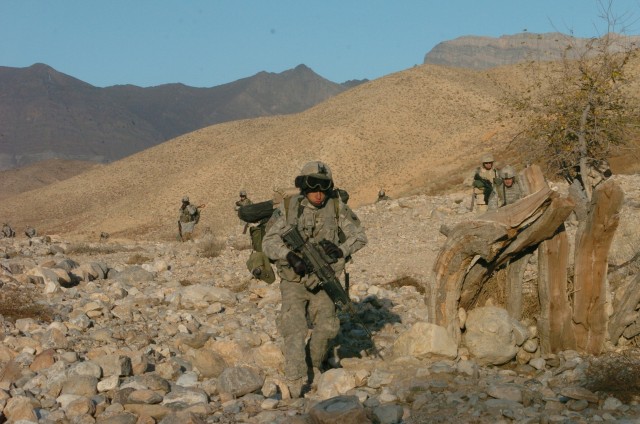DEMING, N.M. (American Forces Press Service, Dec. 1, 2006) - The National Guard Bureau chief assured members of the Army and Air National Guard during a visit here earlier this week that relief is on the way for the Guard's chronic equipment shortages.
The Army National Guard alone will receive almost $29 billion during the next five years to reequip its units, and the Air National Guard will receive a similar sum, Army Lt. Gen. H Steven Blum told National Guard troops serving here along the southwestern U.S. border in Operation Jump Start during his Nov. 29 visit.
That's "almost 29 billion with a 'b,'" Blum said for emphasis.
It also could be "b" for "bravo" for Blum, who's been on something of a crusade -- drawing top-level focus on National Guard equipment shortfalls. He's called the issue one of his biggest challenges, particularly in light of the Guard's vital role in both combat and domestic response missions.
During the National Guard Association's general conference in September, Blum reported that Guard troops "want for nothing in combat," but return home to a "dangerously low resourcing level" for their stateside missions.
This week, Blum told troops serving here of the challenges the Guard faced when Bush announced in mid-May that 6,000 National Guard troops would support the U.S. Border Patrol as it recruits and trains more agents. The operation, expected to last two years, uses National Guard members for support missions, freeing up more Border Patrol agents for front-line law-enforcement missions.
"Look, half the problem with this mission was getting equipment, because most of it was overseas, ... and we didn't have that much back here to move around to you," Blum told the group, made up of volunteers from throughout the country.
The good news, he reported, is that there's now "a very real recognition" among Pentagon and congressional leaders of the need to reequip the Guard's worn-out equipment -- and it's being backed up with desperately needed funding.
Congress is "absolutely adamant that the Guard has to get reequipped" and is watching the issue "like a hawk," Blum said.
"They know how important you are, day to day," he told the troops, pointing to the wide range of missions the National Guard is carrying out throughout the United States and overseas.
"The Guard is busy," he said. "We have 55,000 of us in Iraq, Afghanistan, the Balkans, (the) Sinai (and) the Horn of Africa, a couple of hundred of us down at Guantanamo (Bay, Cuba), 6,000 of us on the southwest border this morning."
In addition, some 8,000 to 10,000 Guard members are serving throughout the United States, providing critical infrastructure protection and responding to disasters ranging from floods to forest fires, he said. In addition, just as hurricane season has come to an end, the National Guard already is geared up to respond to winter-weather emergencies, he said.
"It is unbelievable what the Guard is doing today," Blum told the group. "And you are part of the best Guard that this country has ever put on the ground in its 368 year history."
But all that activity has taken its toll on the National Guard's equipment, he quickly acknowledged. Gear, vehicles and other equipment is wearing out far faster than normal -- as much as five times faster, by some Pentagon estimates.
In addition, many Guard units return from Iraq and Afghanistan without their equipment, leaving it behind for replacement troops. Blum supports that measure, noting that it saves time, money and strain on the logistics system. But the flip side of the coin, he said, is that returning units often lack the equipment they need for training or to respond to a domestic crisis.
States across the country have entered into an agreement to share their National Guard resources to fill in gaps as needed. The Emergency Management Assistance Compact proved its value during the multistate response in the aftermath of Hurricane Katrina in 2005, when several states mobilized their National Guard assets and sent them to help the Gulf states.
But Blum has long emphasized that this kind of cooperation is not a long-term solution to the Guard's chronic equipment shortages. His big concern, he said, is that when the president or one of the 53 U.S. governors calls on their Guard troops, they won't have the equipment they need to provide the "Minuteman" response that's expected of them.
"It is a problem, and we are working it very hard," Blum told the Operation Jump Start troops.
While assuring them that relief is on the way, Blum counseled patience. "We didn't get here overnight," he said. "It took us three to five years to get here, and it will probably take us that long to get out of the hole we are in."


Social Sharing